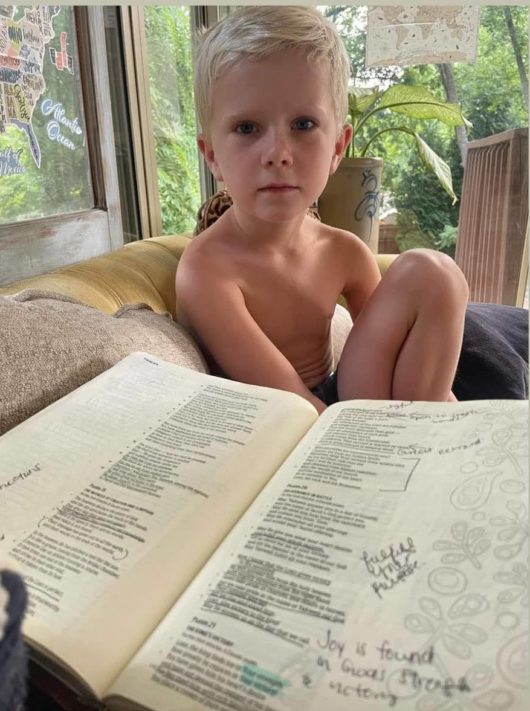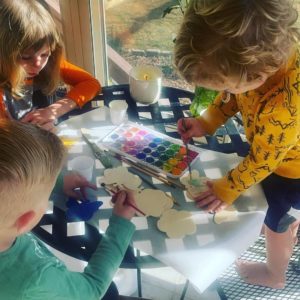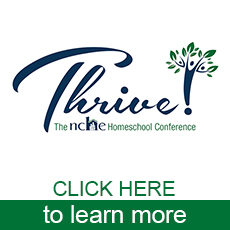
Small Gifts: Big Impact
 by Jessica Frierson, December 2022
by Jessica Frierson, December 2022
I read a very inspiring email this morning from Dr. Jeff Myers, president of Summit Ministries and a featured speaker at past NCHE Thrive! Conferences. He talked about the difference little things can make in big problems. The story he recounted was an amazing one that I had never heard.
As Dr. Myers explained, when communism was growing around the world in the 1960s, many accepted it as inevitable and even extolled its supposed benefits. A small, self-published book, None Dare Call It Treason, written by an unknown author began spreading through word of mouth. Many who read it accused the author of being an evil man spreading lies. However, the book reached the hands of one man who did not share that sentiment. That book eventually lay in a prominent place on the desk of that prominent man, who, in June of 1987, boldly proclaimed to the leader of the communist state of the Soviet Union, “Mr. Gorbachev, tear down this wall!“
The author of the book that inspired President Ronald Reagan to take an unflinching stand against the tyranny of communism was an electrical engineer from St. Louis; he was also an instructor at the small nonprofit Summit Ministries. According to Dr. Myers, “It was John Stormer who encouraged Summit Ministries to publish Understanding the Times—the best-selling worldview text of all time—and develop a curriculum that has trained hundreds of thousands of people in a biblical worldview.” Wow! What a difference one small thing has made!
 NCHE is another small nonprofit working to make a difference in the world. We believe that by helping families homeschool with confidence and joy, we are impacting the lives of families in North Carolina for generations to come. The gamut of services we provide runs from protecting the freedoms of homeschool families by actively monitoring bills presented to the General Assembly to hosting field trips across the state. The NCHE Athletic Commission provides opportunities for thousands of homeschool athletes to participate in eight different sports. We maintain an expansive website with a multitude of resources such as instructions for opening a homeschool, transcript template, testing information, region-specific pages listing area support groups, and a weekly blog. Our office staff speaks with hundreds of families each year, offering solutions to problems they encounter in the homeschool process. At the same time, our new mentor program provides one-on-one guidance from experienced and trained homeschool moms and dads.
NCHE is another small nonprofit working to make a difference in the world. We believe that by helping families homeschool with confidence and joy, we are impacting the lives of families in North Carolina for generations to come. The gamut of services we provide runs from protecting the freedoms of homeschool families by actively monitoring bills presented to the General Assembly to hosting field trips across the state. The NCHE Athletic Commission provides opportunities for thousands of homeschool athletes to participate in eight different sports. We maintain an expansive website with a multitude of resources such as instructions for opening a homeschool, transcript template, testing information, region-specific pages listing area support groups, and a weekly blog. Our office staff speaks with hundreds of families each year, offering solutions to problems they encounter in the homeschool process. At the same time, our new mentor program provides one-on-one guidance from experienced and trained homeschool moms and dads.
These are just a few of the many ways that our organization serves the families in our state. It would take an entire blog post to tell you all of the things that NCHE has been up to in the past year alone (and it would be a long post!). How do these things get accomplished? We are a small organization with only two full-time paid staff members. The majority of our work is done by volunteers who commit hours each week to carry out their commission to serve their fellow homeschoolers. We are mothers with small children, fathers who are working to provide for our families, grandparents who want to ensure their grandchildren continue to receive the benefits of homeschooling, and retirees who are committed to serving even years after their children have grown and graduated.
We fit our NCHE duties into our daily schedule between changing diapers, homeschooling our children, making dinner for our family, taking teens to Speech and Debate competitions, navigating medical crises, moving to a new town, and all the other fine details of life. Often, the sacrifice is great, and our resolve is tested. But we continue on, walking in faith that even the small gift we give of recording a webinar, writing a blog post, hosting a field trip, or taking half an hour to encourage a struggling mother will have an impact on those we reach.
 Like a pebble tossed into a pond spreads ripple after ripple across the water’s surface, our work has already caused significant ripples in the landscape of education in North Carolina and beyond. However, this impact will not remain on the surface but will go much deeper. When parents have the freedom to personalize each aspect of their child’s education to meet that child’s individual needs, that child is prepared to be a world-changer.
Like a pebble tossed into a pond spreads ripple after ripple across the water’s surface, our work has already caused significant ripples in the landscape of education in North Carolina and beyond. However, this impact will not remain on the surface but will go much deeper. When parents have the freedom to personalize each aspect of their child’s education to meet that child’s individual needs, that child is prepared to be a world-changer.
A young man or woman who has learned how to learn – an often-quoted goal of homeschooling parents – has what it takes to reach their full potential. Tossing aside the mold that students must conform to in any other educational setting to freely explore the unique gifts, talents, interests, and skills of the homeschooled child is invaluable. This freedom is only attainable with homeschooling.
What part can you play in this endeavor to impact our world? NCHE has many seats to fill around the table. Our needs are as varied as the services we provide. They include IT, writing (blog posts, GREENHOUSE articles, show content), video production, photography, social media, and marketing. Contact us today to find out where we can best use your skills and interests.You can email me at jessica.frierson@nche.com, and I will make sure your information reaches the correct department.
As we reach the end of our fiscal year, your financial gift can make a big impact to our ministry. No gift is too small to make a difference. I doubt that John Stormer ever imagined the part his small book would play in tearing down the wall of communism that symbolically and physically separated the free world from those in bondage. My children have a beautiful storybook by Max Lucado called “Small Gifts in God’s Hands.” It teaches us that we should never doubt the power of God to multiply our gifts – no matter how small – in order to accomplish His purposes. He only asks that we act in faith and obedience to freely give what He has already given us.
 Tell others about NCHE! A tiny percentage of the homeschool families in North Carolina are aware of the organization that worked to give them that same opportunity. They do not know that the resources they are searching for are available at our website. They have never attended the Thrive! Conference, where they can listen to great speakers like Jeff Myers of the Summit Ministries, make powerful connections in the homeschool community, and pour over hundreds of curriculum options in the vendor hall. They are counting on NCHE to protect their continued freedom to homeschool without even realizing who we are. The best way we have to reach these families is through word of mouth. That means YOU! Tell other homeschoolers about our website, invite your friends to meet you at the conference, and share our posts on Facebook and other social media outlets. Please spread the word about the work we are doing, and help us impact our world, one small gift at a time.
Tell others about NCHE! A tiny percentage of the homeschool families in North Carolina are aware of the organization that worked to give them that same opportunity. They do not know that the resources they are searching for are available at our website. They have never attended the Thrive! Conference, where they can listen to great speakers like Jeff Myers of the Summit Ministries, make powerful connections in the homeschool community, and pour over hundreds of curriculum options in the vendor hall. They are counting on NCHE to protect their continued freedom to homeschool without even realizing who we are. The best way we have to reach these families is through word of mouth. That means YOU! Tell other homeschoolers about our website, invite your friends to meet you at the conference, and share our posts on Facebook and other social media outlets. Please spread the word about the work we are doing, and help us impact our world, one small gift at a time.
Jessica Frierson is a homeschool graduate and has been homeschooling her ten children since 2000. She serves as the secretary for NCHE, writes for GREENHOUSE, and is the lead blogger for the NCHE blog.
Small gift photo by Rob Laughter on Unsplash. Passion photo by Ian Schneider on Unsplash. Ripple in pond photo by Jessica Frierson. Tell others photo by Mimi Thian on Unsplash.
Instilling Gratitude in Our Children
by Jessica Frierson, November 2022
November is the season of gratitude, culminating in a national observance of Thanksgiving Day. George Washington began the tradition of a national day of thanksgiving in 1789. Washington had previously ordered special days of thanksgiving for his troops following successful battles during the Revolutionary War. President Lincoln called on our nation to remember the blessings and provisions of God even amid a war-torn landscape in his Thanksgiving Day Proclamation on October 3, 1863. He poignantly reminded us, “No human counsel hath devised, nor hath any mortal hand worked out these great things. They are the gracious gifts of the Most High God, who while dealing with us in anger for our sins, hath nevertheless remembered mercy.”
The practice of setting aside a day to give thanks to God for His care and provision goes back to the earliest days of our nation. According to www.mountvernon.org, “Colonists often established Thank Days to mark certain occasions. These one-time events could occur at any time of the year and, emphasizing prayer and spiritual reflection, were usually more solemn than the Thanksgiving we observe today.”
No history of Thanksgiving Day would be complete without remembering the 1621 occasion of the Pilgrims’ famous feast with the neighboring Wampanoag, and again two years later with a day of praise to God for rain after a two-month drought. But credit for the first annual Thanksgiving observance goes back to 1619 with a group of thirty-eight English settlers who comprised the first permanent settlement in the Virginia colony. The group’s charter from the London Company dictated that, “the day of our ships arrival at the place assigned for plantation in the land of Virginia shall be yearly and perpetually kept holy as a day of thanksgiving to Almighty God.” In keeping with this, an annual commemoration of this earliest documented day of thanksgiving is observed at the Berkeley Plantation, located near the site of their landing along the James River in Virginia.
Oh come, let us sing to the Lord! Let us shout joyfully to the Rock of our salvation. Let us come before
His presence with thanksgiving; Let us shout joyfully to Him with psalms. Psalm 95:1-2
Sadly, the Thanksgiving holiday in America has lost much of its focus on consecration to God, gratitude for His grace and provision for the past year, and prayer for the year to come. It has become largely synonymous with family spats, gorging ourselves on turkey “with all the fixin’s,” and football. Gone are the days of solemnity, selflessness, and unity. Thanksgiving aside, our culture today is overcome with self-gratification, which is hardly compatible with gratitude. This loss does not come as a surprise, however, as we are warned in 2 Timothy 3:1-3 that a lack of gratitude will characterize life in the last days:
“But know this, that in the last days perilous times will come: for men will be lovers of themselves, lovers of money, boasters, proud, blasphemers, disobedient to parents, unthankful, unholy, unforgiving, slanderers, without self-control, brutal, despisers of good, traitors, headstrong, haughty, lovers of pleasure rather than lovers of God, having a form of godliness but denying its power. And from such people turn away!”
As parents, we must not only guard against this type of attitude within ourselves but must also be diligent to cultivate in our children seeds of kindness, thankfulness, humility, obedience, holiness, truthfulness, a love for God, and consideration for others. I believe that all of these attributes are interwoven with a spirit of gratitude.

What makes a person feel grateful? The foundation is an appreciation for what you have and a realization that it is a gift from God. We most appreciate what we have when we have gone through a time of being without those things. Conversely, the more someone has, the less grateful they tend to be.
When our neighborhood was hit by a tornado several years ago, we had a lengthy power outage. I recall how satisfying it was to put away the kerosene lamps and flood our home with light at the flick of a switch once again when the power was restored. What a wonderful feeling when cool air once again flowed from our air conditioner! Things we would otherwise take for granted take on new meaning when lost to us.
Piglet noticed that although he had a Very Small Heart, it could hold a rather large amount of Gratitude. ~ A. A. Milne
To help our children appreciate the blessings and privileges that fill their lives, we could shut off the water and electricity or take them to a third world-country to live for a few months. As a less drastic measure, offer them a look at life through the perspective of someone else who doesn’t enjoy those same luxuries. Often, we are unaware of how privileged we are compared to many others in the world.
This lack of awareness was made clear to me one day many years ago when my oldest sons were small. They were visiting their grandmother’s house, and she brought out a basket of Hot Wheels and Matchbox cars for them to play with. My youngest brother, a teenager then, came inside with a friend who had recently immigrated from Central America. He came to a complete stop when he saw the basket of cars. In a state of amazement, he knelt and picked one up, looking at it from every angle before giving its wheels a spin. He stayed there for some time, looking at one car after the other, driving them around on the floor with my sons. He went on to share that he had never had a toy of any kind in all his life and had always dreamed of having one – just ONE – toy car like these. Twenty years later, I can still picture his face and vividly feel the overwhelming emotions I felt that day. I witnessed his reaction to what was a very ordinary plaything to us but an unreachable dream for that young man.
As we express our gratitude, we must never forget that the highest appreciation is not to utter words but to live by them. ~ John F. Kennedy
How can you instill a spirit of gratitude in your child? Teach them to live so that their eyes, ears, and hearts are continually open to the needs of those around them. Pray with them that God would open a door of ministry for them. Look for an organization they can get involved with that will allow them to share what they have to fill those needs. It may be giving of their time, talents, money, or ideas. Whatever way they choose to give, teach them that the best gifts are those wrapped in love. Using the gifts God has given them to improve the life of others offers a way to put their gratitude into action and helps them fulfill God’s command to love their neighbor. Remind them also that praying for others is the most powerful gift.
This season is a great time of year to partner with organizations serving those in need. Here are a few places that offer various ways you and your family can help.
- Operation Christmas Child Shoeboxes: your child can pack a shoebox with school supplies, personal hygiene items, a small stuffed animal, or a deflated soccer ball with a pump to be distributed to impoverished children worldwide. Older kids can volunteer to work in the distribution center, preparing shoe boxes for shipping.
- In addition to the Shoebox project, Samaritan’s Purse offers many opportunities to take a proactive role in improving the lives of others. You can donate to projects that assist refugees, rescue those caught in human trafficking, set up field hospitals to serve in a medical crisis, provide hot meals to a hungry child or infant, drill a well for a community, plant a grove of trees, teach efficient and sustainable farming techniques, empower vulnerable women, assist a family devasted by a natural disaster, or, our family’s favorite: purchase an animal for a needy family that will allow them to feed themselves and establish ongoing income by raising chickens, rabbits, goats, or other livestock.
- VOM Action Packs: Voice of the Martyrs assembles Action Packs that are distributed worldwide to persecuted Christians. They are often disseminated via refugee camps. The Action Packs contain soap, towels, a tarp, zip ties, a blanket, a sheet, and a toy. You can purchase the items and mail them to VOM or make a donation that is specified for one.
- Did you know that the Salvation Army is often the first relief response during floods, tornadoes, hurricanes, earthquakes, house fires, or even acts of violence such as rioting? There are many ways to contribute to the efforts of the Salvation Army. Just a few of the avenues your donation may be used for are providing Christmas gifts for children in your community, helping a needy family pay their electric bills, supporting disaster relief efforts, sponsoring a child overseas, and providing support for recovering addicts.You can also donate clothing, toys, household items you no longer use, and real estate or automobiles. Adults can also serve on their local advisory board, set up fundraisers, volunteer in one of their thrift stores, or serve in the local shelter. (Personal note: my husband’s parents were SA officers. Although their salary was modest, they always had a home—often furnished—and an automobile provided for their use in each city where they were stationed that had been donated to the Salvation Army. My sister-in-law adopted one of my nephews after meeting him at the SA shelter where she was serving with my father-in-law.)
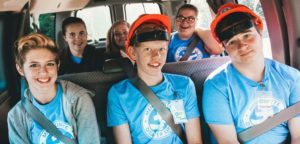
- While the Salvation Army is often among the first responders to a disaster, Mennonite Disaster Relief is often the last to leave hard-hit areas. This organization provides disaster relief to families by rebuilding homes and sometimes even bridges damaged or destroyed by floods, hurricanes, or other natural disasters. Their focus is on long-term recovery. For example, according to Communications Director Jesse Huxman, the MDR team just returned from Marianna, FL, where they have worked for the past few years helping families who are recovering from a hurricane that hit in 2017. In Jesse’s words, “We are often in there two, three, or even more years after a storm has hit where folks are still living in their cars or an old, rotting RV out back because their house is not livable. Volunteers go in and repair or rebuild the home long after all of the other relief workers have left town.”MDR also offers summer youth programs that consist of projects for high school-age kids. They are assigned to work on weekly projects in disaster-stricken areas. The work may include hanging drywall, painting, installing flooring or insulation, laying roof shingles, or doing other rehabilitation chores. No prior experience is required, and they will teach the kids how to do what needs to be done.
As your family gathers together this Thanksgiving, contemplate the many ways God has worked in your lives. Talk together about His goodness and faithfulness to you. Make a plan for putting your words of gratitude into action. Consider giving your time and/or money to one of the ministries listed above or ask God to allow you to cross paths with someone you can minister to. Be sure to include your children in this. Ask them for ideas on how your family can serve others. You may be surprised at the insight they have and the creativity they show. Children often notice details we may miss, especially if we teach them to listen to the Holy Spirit speaking to their hearts. You will all find that the more you serve others, the more grateful you will be and the greater joy you will experience in life.
Jessica Frierson is a homeschool graduate and has been homeschooling her ten children since 2000. She serves as the secretary for NCHE, writes for GREENHOUSE, and is the lead blogger for the NCHE blog.
Grateful photo by Nathan Dumlao on Unsplash Gratitude rocks photo by Donald Giannatti on Unsplash. Boys on bus photo credit Paul Hunt, MDR. Photo by Rustam Mussabekov on Unsplash
Teaching a Child to Read
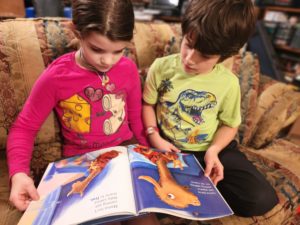 by Jessica Frierson, November 2022
by Jessica Frierson, November 2022
One of the greatest achievements of my life is passing on the gift of knowing how to read. Reading opens the door to learning every other subject. It can take one to faraway lands or offer a peek into another person’s heart. Your world will grow larger with each book you read.
I have had the distinct pleasure of teaching ten (soon to be eleven) people to read over my lifetime thus far. This thrill was first experienced when I was only thirteen years old. My seventh-grade English teacher found herself with an accelerated student mistakenly placed in her class rather than the advanced one and a student whose family had recently immigrated here from Nigeria. My classmate Tayo could not read a word of English while I had taken my literature book home and read it from cover to cover during the first week of school.
Our clever teacher paired us up. From that point on, when I arrived at my 6th-period class each day, Tayo and I pushed our chairs together at the back of the room. Head-to-head, we worked through the alphabet and the sound each letter makes, consonant blends and digraphs (although I had no idea that’s what they were called at that time), long and short vowels, and the crazy intricacies of the English language. By the end of the school year, Tayo could read enough to make it through her classes without an aide, while I was given the incredible gift of being a part of the process with her.
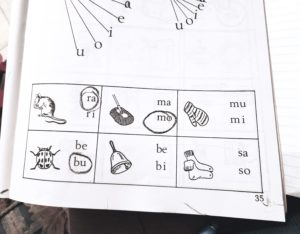 Years later, when I began homeschooling my first son, I again felt the joy in seeing that moment when it all “clicked” in his mind as he began putting sounds together to make a word. In fact, this is one of my favorite things about homeschooling; I would not easily give up this privilege to a classroom teacher. I have now worked through the process of learning to read with nine of my children and am presently teaching my youngest one. I am frequently asked, “How do you teach a child to read?” or “What reading program do you use?” Let me share with you what has worked for me.
Years later, when I began homeschooling my first son, I again felt the joy in seeing that moment when it all “clicked” in his mind as he began putting sounds together to make a word. In fact, this is one of my favorite things about homeschooling; I would not easily give up this privilege to a classroom teacher. I have now worked through the process of learning to read with nine of my children and am presently teaching my youngest one. I am frequently asked, “How do you teach a child to read?” or “What reading program do you use?” Let me share with you what has worked for me.
We start with a handwriting book. We use the Italic Handwriting series by Getty-Dubay, but any handwriting system would suffice. I also keep some of those Dollar Store blank handwriting tablets on hand for additional practice. As my child learns how to write a new letter, I also teach him the sound it makes. Most handwriting books will have a drawing to go with the letter, such as an elephant for “E” or an igloo for “I.” As the child moves through the book, I quiz him each day on the previous letters he has learned, covering up the drawing unless he needs a clue to help him recall it.
 Along with the handwriting books, I pour a thin layer of cornmeal on a cookie sheet and let my child draw the letters in the cornmeal while saying the sound it makes. This extra layer of sensory input helps the child’s brain form a stronger synaptic connection. After we have gotten through 8-10 letters, I draw a letter and have him guess or the reverse: I make the sound for him to draw the corresponding letter.
Along with the handwriting books, I pour a thin layer of cornmeal on a cookie sheet and let my child draw the letters in the cornmeal while saying the sound it makes. This extra layer of sensory input helps the child’s brain form a stronger synaptic connection. After we have gotten through 8-10 letters, I draw a letter and have him guess or the reverse: I make the sound for him to draw the corresponding letter.
We also have enjoyed using the workbooks from Pathway Publishing called Learning Through Sounds and Time to Read. They have simple line drawings that further reinforce each letter’s phonetic sound. An Amish publisher prints these, so we occasionally encounter a drawing that I have to explain, such as a buggy, bonnet, or water pump. These have provided an interesting peep into another culture that my children have found intriguing.
As each child progresses through the alphabet, they discover letters in the world around them. They have all reached a point where they realize that there are letters everywhere – and how exciting for them to recognize them! As we move to the next step, their excitement grows even more. Three-letter words with short vowel sounds show how putting the letters together creates a word. The workbook pages they have been doing have already introduced them to the concept of rhyming and taught them to listen for the beginning and vowel sounds in words. Now they apply those basic skills to words like C-A-T, B-A-T, F-A-T and F-O-G, D-O-G, L-O-G. Next, I will switch vowel sounds in the middle of words, as in P-I-T, P-A-T, P-O-T, and P-E-T. It is typically at this point that they experience the “light bulb over the head” moment, and their eyes light up with understanding.
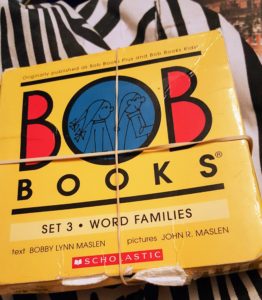 The next step in teaching my children to read is adding an “E” at the end of words to create a long vowel sound. C-A-P becomes C-A-P-E, K-I-T becomes K-I-T-E, and H-O-P becomes H-O-P-E. At this stage, we may employ some beginner readers, such as the Bob Books series. We have also used a set from Abeka. These will have short stories that the child can read with only these simple introductory words. You can often borrow the Bob Books from the public library.
The next step in teaching my children to read is adding an “E” at the end of words to create a long vowel sound. C-A-P becomes C-A-P-E, K-I-T becomes K-I-T-E, and H-O-P becomes H-O-P-E. At this stage, we may employ some beginner readers, such as the Bob Books series. We have also used a set from Abeka. These will have short stories that the child can read with only these simple introductory words. You can often borrow the Bob Books from the public library.
Once my child has reached this stage, they begin the first in a series of readers. The ones that our family has used for over twenty years are the Pathway Readers, published by the same company that makes the workbooks previously mentioned. Each reader has an accompanying workbook. In the first few lessons of the first reader, the parent reads the first paragraphs of the story of the day, and then the child reads a paragraph or two. The focus of the workbook pages is on reading comprehension, continuing phonics practice, beginning grammar rules, and spelling. Gradually, the portion of the reading done by the parent is phased out as the child’s capacity increases. (By the way, these readers go up through the eighth grade if you continue with the series. For our school, we add a vocabulary workbook by the same publisher beginning with the 3rd or 4th grade.)
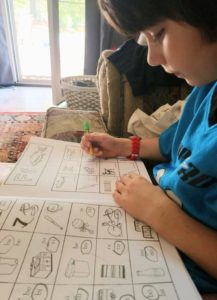 You may be wondering at what age we begin this process of learning to read. As my child approaches age five, I begin to watch for signs of reading readiness. Pretending to read their story books, copying letters that they see in a book or on one of our school room (a.k.a. dining room) posters, and asking to be taught are good indicators. These activities show that their brains are reaching a stage of development that is prepared for grasping phonics concepts without it being stressful to them. Unfortunately, I have seen many children become turned off from reading because it was pushed on them too early or too fast.
You may be wondering at what age we begin this process of learning to read. As my child approaches age five, I begin to watch for signs of reading readiness. Pretending to read their story books, copying letters that they see in a book or on one of our school room (a.k.a. dining room) posters, and asking to be taught are good indicators. These activities show that their brains are reaching a stage of development that is prepared for grasping phonics concepts without it being stressful to them. Unfortunately, I have seen many children become turned off from reading because it was pushed on them too early or too fast.
A couple of my children began reading at the age of five. For others, it was a couple of years later. If they showed signs of stress or distaste at any stage of this process, I backed off for a short time, then eased into it again a few months later. As a result, every one of my children has gone from the point of truly grasping the formation of short vowel words to reading entire story books in a matter of months. Most were seven years old when we really got into their reading lessons but by the end of their first school year, all were reading on a second-grade level. I am convinced that the most vital key to this was waiting until each child was ready.
 All of my children share their mother’s love of reading. I have read to them from infancy and continue to read to them regularly, even as they grow into their teenage years. We listen to books on tape when we are driving, particularly on long trips. Some of our family favorites are the Little House on the Prairie series, The Basket of Flowers, and All-of-a-Kind Family. We have bookshelves in nearly every room of our house that are filled with hundreds of books. We are on a first-name basis with the librarians at our local branch. Getting their first library card on their fifth birthday is a family tradition. Reading is a passion that I have been thrilled to share with others.
All of my children share their mother’s love of reading. I have read to them from infancy and continue to read to them regularly, even as they grow into their teenage years. We listen to books on tape when we are driving, particularly on long trips. Some of our family favorites are the Little House on the Prairie series, The Basket of Flowers, and All-of-a-Kind Family. We have bookshelves in nearly every room of our house that are filled with hundreds of books. We are on a first-name basis with the librarians at our local branch. Getting their first library card on their fifth birthday is a family tradition. Reading is a passion that I have been thrilled to share with others.
If you have questions about teaching your child to read or need advice on other areas of homeschooling, NCHE offers one-on-one mentoring sessions. One of the benefits of membership is a complimentary 30-minute session with one of our trained mentors. Additional sessions can be purchased. Check out our mentor page for more information.
 Jessica Frierson is a homeschool graduate and has been homeschooling her ten children since 2000. She serves as the secretary for NCHE, writes for GREENHOUSE, and is the lead blogger for the NCHE blog.
Jessica Frierson is a homeschool graduate and has been homeschooling her ten children since 2000. She serves as the secretary for NCHE, writes for GREENHOUSE, and is the lead blogger for the NCHE blog.
All photos by Jessica Frierson
A Journey Well-planned
Dana McDill and Jessica Frierson, October 2022
 Much like life itself, the course of homeschooling is not about the destination but the journey. Reaching that moment when we present our child with a diploma may be the prevailing image when we consider a vision for our homeschool. However, the journey to get to that point is what will shape our child’s future in an even greater way.
Much like life itself, the course of homeschooling is not about the destination but the journey. Reaching that moment when we present our child with a diploma may be the prevailing image when we consider a vision for our homeschool. However, the journey to get to that point is what will shape our child’s future in an even greater way.
Know Where You Are Going
When starting any new endeavor, it is important to know where you are going. At whatever stage of your homeschooling journey you may be, I encourage you to write out a vision for your homeschool. At first glance, the goal of homeschooling is rather obvious: educate my child. And while that may be the foundation of your goal, you will want to take some time to paint the broader picture around that. As you do so, here are some tips to keep in mind:
1. Be purposeful and intentional. Consider the qualities that you want to work on strengthening in your child. Remember that a fulfilling life involves far more than having a successful career. Yet, many parents tend to focus on career-based skills and neglect the characteristics that define the kind of person their child will grow to be, such as building strong relationships, integrity, gratitude, perseverance, and faith.

2. Set priorities. Ask yourself (and your child) what the most important pursuits are for the upcoming year, then take a moment to think about how those pursuits fit into your long-term goals. Keep in mind that many activities will require a high level of commitment that may not be worth the time and effort invested. Sports, dance, debate club, orchestra, and equestrianism are examples of activities that our family has considered at some point. Some we determined were investments we were willing to make; others we decided were not priorities for us.
Another aspect of setting priorities is considering what will be most meaningful for your children to remember from their childhood, including their school days. Will it be a home that looks like a page from Better Homes and Gardens, or will it be memories of blanket forts and a teddy bear tea in the dining room? Some families prioritize travel to see our country—or even the world! – while others give precedence in their time and resources to activities that keep them tied down closer to home.
3. Don’t compare yourself, your child, or your homeschool to others. You can find inspiration in or learn some strategies from other families but be on guard against allowing comparisons to creep into your thinking. Know that what works well for one family may not work for yours. Beware of letting a picture-perfect image you may see on social media stir up feelings of inadequacy in your heart. Remember that no one does everything well.
4. Know your limitations. A new baby in the home, toddlers, outside responsibilities, and medical conditions – these are just a few of the myriad factors that must be considered. Don’t set yourself up for failure by stretching your expectations for yourself or your family beyond what is reasonable.
No Sideroads!
Once you have set your vision, you must work to stay on track. Just as with any journey, you need to stick to your itinerary. Distractions come from a variety of fronts. The Bible warns us that we have an enemy, Satan, who is busily trying to distract us from God’s purposes. One specific piece of our spiritual armor is for our defense against this very thing. Ephesians 6:16 instructs us to take up “the shield of faith with which you will be able to quench the fiery darts of the wicked one.” Some of these fiery darts that he shoots at us include feelings of fear, regret, guilt, or of being a failure.
itinerary. Distractions come from a variety of fronts. The Bible warns us that we have an enemy, Satan, who is busily trying to distract us from God’s purposes. One specific piece of our spiritual armor is for our defense against this very thing. Ephesians 6:16 instructs us to take up “the shield of faith with which you will be able to quench the fiery darts of the wicked one.” Some of these fiery darts that he shoots at us include feelings of fear, regret, guilt, or of being a failure.
Busyness or outside activities can derail our well-laid plans. Having the wrong priorities is sure to get us off track before long. There are even times when we become our worst distractions!
You must ensure that these distractions do not take your homeschool down a sideroad. Put your blinders on; stay focused on where you are headed. Don’t settle for what is good; only do what is best – and that means best for your family. And when a distraction seemingly appears, submit it to the Lord. Ask Him to help you remove it or ignore it if it is not from Him. This is an important step. There have been rare times when what I perceived as a distraction was, in fact, a detour ordained by the Lord. However, there are far more occasions when the detour I took was nothing more than a setback of my own doing. Prayer is the key to discerning the difference.
Stay Focused
Psalm 16:8 shows us what a lifeline the Lord can be for us: “I have set the Lord always before me; because He is at my right hand I shall not be moved.” When I begin to falter, I remind myself that God’s work done in God’s way will never lack God’s supply. Keeping my vision ever before me, as I give God the reins, I can trust that He will keep me on track for where He wants to take my family.
 Your role as wife and mother must not get swallowed up by your secondary role of teacher. Seek ways to serve your husband and to have time alone with just the two of you. Your marital relationship is the bedrock of your family, and thereby, your homeschool. Cherish the time you spend with your children, whether around the school table or doing other activities together. These are precious days that will slip by faster than you can imagine!
Your role as wife and mother must not get swallowed up by your secondary role of teacher. Seek ways to serve your husband and to have time alone with just the two of you. Your marital relationship is the bedrock of your family, and thereby, your homeschool. Cherish the time you spend with your children, whether around the school table or doing other activities together. These are precious days that will slip by faster than you can imagine!
One day, you will look back on the years spent homeschooling your children with the satisfaction of having completed a long and difficult task. The journey you will have traveled to get to that point will have taken you through valleys of despair, brought you to mountaintop victories, and jostled you over many bumpy roads. You will feel as if the world rushed past in a blur one moment and turned ever so slowly the next. Having a clearly laid-out plan for your journey will not only be the guidebook for you to follow to stay on track, but it will also serve as a record of the tremendous achievements you and your family made along the way.
 Dana McDill is the wife of NCHE’s executive director, Matthew McDill. They live in Clemmons, NC, with six (ages 17 to 8) of their nine children. Their oldest daughter is married and their two oldest boys are in college. She has been homeschooling for 19 years. She loves to come alongside and encourage moms because she knows well the challenges of the journey. She doesn’t claim to be an expert because she knows God is still refining her! She hopes some of the lessons she has learned will help you!
Dana McDill is the wife of NCHE’s executive director, Matthew McDill. They live in Clemmons, NC, with six (ages 17 to 8) of their nine children. Their oldest daughter is married and their two oldest boys are in college. She has been homeschooling for 19 years. She loves to come alongside and encourage moms because she knows well the challenges of the journey. She doesn’t claim to be an expert because she knows God is still refining her! She hopes some of the lessons she has learned will help you!
Jessica Frierson is a homeschool graduate and has been homeschooling her ten children since 2000. She serves as the secretary for NCHE, writes for GREENHOUSE, and is the lead blogger for the NCHE blog.
All photos by Jessica Frierson
____________________________________________________________________________________________________
Lesson from the Trees: Learning to Let Go
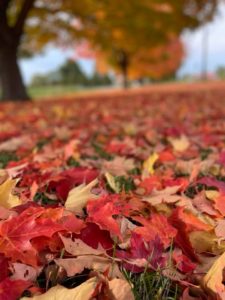 by Jessica Frierson, October 2022
by Jessica Frierson, October 2022
As October rolls around and the temperatures drop, the world outside my windows has become much more colorful. It’s my favorite time of year. Not only is the weather perfect (in my opinion anyway) and the fall foliage so beautiful, but I am always reminded of an important concept as I watch the trees prepare to drop their multi-colored leaves. There is a time to let go.
All the trees are losing their leaves, and not one of them is worried.” — Donald Miller
We tend to hold onto things that should be let go. One of the saddest TV programs I have seen is the reality program, Hoarders. This show features individuals who face crises “ranging from jail time to financial ruin and loss of property” due to their unwillingness or inability to let things go. Experts work with them to solve their hoarding addiction “in the hope of reclaiming balance in their lives,” according to the show’s website.
Our homes may not be so full of accumulated boxes, papers, and to-go containers that the production crew of Hoarders is headed our way; maybe because the things that we hoard overcrowd our thoughts, our hearts, and our motivations, where they are not as visible as the items that fill the corners of our homes. Fear, doubts, unmet expectations, unresolved conflicts, anger, bitterness, guilt, jealousy, grief, hatred: these are the things that clutter the corners of our minds. They cripple us to the point that we face crises of our own if we are not willing to let them go.
 We can lock ourselves in the prisons of past mistakes while holding the key in our hand that would set us free. Being unwilling to release others when they have wronged us is another way we imprison ourselves. Past regrets do not serve well as a ballast until we learn to unload them. The accumulation of out-of-season trappings will soon lead to a life that has lost balance. A healthy practice is to periodically take stock of any “if onlys” and “I wishes” that are hiding out in the back of our thoughts and ask God to help us let go of them, even if He has to pry them out of our tight-knuckled fingers to do it.
We can lock ourselves in the prisons of past mistakes while holding the key in our hand that would set us free. Being unwilling to release others when they have wronged us is another way we imprison ourselves. Past regrets do not serve well as a ballast until we learn to unload them. The accumulation of out-of-season trappings will soon lead to a life that has lost balance. A healthy practice is to periodically take stock of any “if onlys” and “I wishes” that are hiding out in the back of our thoughts and ask God to help us let go of them, even if He has to pry them out of our tight-knuckled fingers to do it.
My son is in the Civil Air Patrol. Before heading out on a search-and-rescue mission, they are given a packing list. It is crucial that each team member brings everything on the list – and nothing else besides what is on the list. Adding additional items will make their 24-hour packs too heavy, weakening the ability to carry out the mission. How often do we undermine ourselves by carrying extra baggage that we should have released long ago? These things become burdens that weigh us down and hinder our success.
The same principle applies to our homeschools. Sometimes the curriculum we loved for a season does not fit another. The co-op or support group that was such an encouragement and enrichment last year may not be the right place for us this year. We may have planned a graduation ceremony for our upcoming graduate in keeping with what their siblings had, only to find out that they dread being the center of attention.
The wise king Solomon understood the value of seasons in our lives, writing in the third chapter of the book of Ecclesiastes:
 To everything there is a season,
To everything there is a season,
A time for every purpose under heaven:
A time to be born,
And a time to die;
A time to plant,
And a time to pluck what is planted;
A time to build up,
A time to break down,
A time to keep,
And a time to throw away
As our children move through the stages of toddlerhood, elementary school, middle school, and high school, the change in seasons of education can vary as greatly as the winter snow varies from the summer drought. As they move through these seasons, we must be ready to move with them, laying down the accouterments of the past to enter the new one unhindered.
When the winds of change blow, remember… sometimes what appears dead is simply preparing
for a new season.” — Jane Lee Logan
 Grasping onto those things that belong to another season will keep us from enjoying the fullness of where we are. We may have ideas of what we wanted our children to do or what we thought parenthood would be. Our lives may have gone in a different direction than what we had once thought they would. We have the choice of clinging to the loss of what once was or moving into the freshness of a new season. A fixation on the glory of bygone days will cause us to miss the beauty presently around us.
Grasping onto those things that belong to another season will keep us from enjoying the fullness of where we are. We may have ideas of what we wanted our children to do or what we thought parenthood would be. Our lives may have gone in a different direction than what we had once thought they would. We have the choice of clinging to the loss of what once was or moving into the freshness of a new season. A fixation on the glory of bygone days will cause us to miss the beauty presently around us.
“Even as the leaves are falling, the buds of next year’s crop are already in place, waiting to erupt again in spring . . . It’s just getting on with it quietly.”
―Katherine May
One of our daughters recently received an unexpected and life-altering medical diagnosis. Even as the doctor spoke the words, I knew there were expectations in her life that would now need to be let go. Knowing that her Creator loves her even more than I ever can, I trust that God was opening a different door for her to walk through by allowing the condition the doctor was describing to us. Our faith teaches us that what we may see as the death of something is, in fact, the passage to growth and abundant living. In John 12:24-25, Jesus sets the stage for demonstrating this principle in His own life: “Most assuredly, I say to you, unless a grain of wheat falls into the ground and dies, it remains alone; but if it dies, it produces much grain. He who loves his life will lose it, and he who hates his life in this world will keep it for eternal life.”
“Anyone who thinks fallen leaves are dead has never watched them dancing on a windy day.” ― Shira Tamir
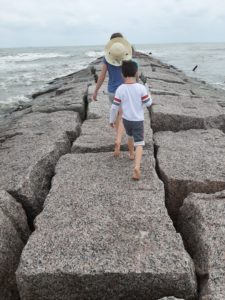 Sometimes in life, we find ourselves on a narrow ledge with the only path forward one that requires us to let go of the relative security of the wall behind us. We must step out in faith and grasp God’s hand as He leads us on a path so shrouded in uncertainty that we cannot see the way before us. That path may be the one that leads us to homeschooling in the first place, or it may be one that calls us to continue on it even when the path becomes steep and rocky.
Sometimes in life, we find ourselves on a narrow ledge with the only path forward one that requires us to let go of the relative security of the wall behind us. We must step out in faith and grasp God’s hand as He leads us on a path so shrouded in uncertainty that we cannot see the way before us. That path may be the one that leads us to homeschooling in the first place, or it may be one that calls us to continue on it even when the path becomes steep and rocky.
A successful journey on that path requires that we let go of the things that will hinder us from thriving. Releasing them empowers us to engage fully in the vibrancy of life around us. Our clouded vision clears as we focus only on what is relevant: the path before us. Precious memories of yesteryear sweeten the experience and energize us for the race yet to come but only if relegated to their proper place. Hopes and dreams for the future draw us onward, but again, they must be held in check. The contrast between just passing by this season as you wait for the next and being fully immersed in the season of life where we are presently is the difference between looking at these photographs of beautiful leaves and taking a hike along a mountain trail with the flutter of falling leaves gently nudging your shoulders and the cool autumn breeze whispering in your ear. I don’t know about you, but I want the full experience, whatever challenges and heartaches it may bring. So, like those trees dropping their summer wardrobes, I am learning to let go.
Jessica Frierson is a homeschool graduate and has been homeschooling her ten children since 2000. She serves as the secretary for NCHE, writes for GREENHOUSE, and is the lead blogger for the NCHE blog.
Top photo credit: Sandra Cloer. Other photos: Jessica Frierson
Expanding Our Reach – A Multicultural Update
 by Te’Essence Mack, September, 2022
by Te’Essence Mack, September, 2022
At NCHE we have a mission to serve all NC homeschooling families so they can homeschool with confidence and joy. We are always looking for ways to improve so we can serve more families more diligently. The recent growth in the homeschooling community has brought with it an increase in diversity. As more families are coming from different ethnic, racial, and linguistic backgrounds with unique experiences and goals for home education, NCHE has been making strides to ensure the needs of this population are highlighted and met. Here’s how:
- Created multicultural liaison positions to help concentrate efforts towards reaching the African American and Hispanic communities, as well as facilitated racial/cultural discussions within the organization
- Hosted a multicultural webinar and chat to begin having meaningful discussions in support of unified diversity
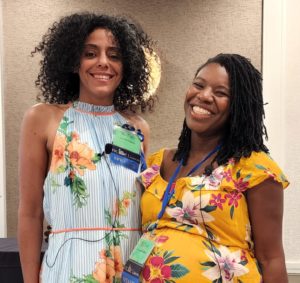
- Created the multicultural committee to support, plan, and execute such efforts in favor of unified diversity
- Hosted regularly occurring homeschool conversations in Spanish to begin providing meaningful content to Spanish-speaking ESL families
- Made personal connections with Hispanic and African American homeschool leaders and speakers to increase their representation and offer many opportunities for their voices to be heard and faces to be seen
- Used social media homeschool groups to spread the word about our efforts and make a positive connection with diverse homeschooling families
- Had conversations on The Homeschool Show (featured on radio, podcast, and Youtube) about the need for intentional, unified diversity
- Hosted an in-person multicultural connect event to give diverse families the chance to connect with others in their area

- Included two African Americans as co-hosts on The Homeschool Show (featured on radio, podcast, and YouTube)
- Will be using The Homeschool Show (featured on radio, podcast, and YouTube) to capture conversations with all families
- Introduced at Thrive! Conference the first African American regional liaison for Region 4, which covers Mecklenburg, Union, Cabarrus, Gaston, Rutherford, Cleveland, and Lincoln counties
- Hosted Multicultural Connections, a one-hour workshop at the Thrive! Conference, in which we provided resources and encouragement, allowed for discussion and connection, and had games and giveaways. Diverse families had the chance to meet each other and get plugged into NCHE to further diversify the organization. This was hosted by our multicultural liaisons in English and Spanish
- Hosted a Multicultural Gathering at the Thrive! Conference. This was another touch point to allow diverse families to meet each other and get plugged into NCHE. This was also hosted by our multicultural liaisons in English and Spanish
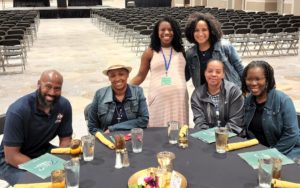 This is just a summary of what we’ve been working on over the past year. We are looking forward to furthering these efforts, expanding our reach, and connecting with more homeschooling families of different ethnicities and cultures. We will continue this work because we believe that we will all be enriched by a more ethnically and culturally diverse homeschool experience. At the end of the day, we are all homeschooling families wanting the best for our kids, and NCHE is here to make sure that happens. We are here, and we are working so all families have the privilege to homeschool with confidence and joy.
This is just a summary of what we’ve been working on over the past year. We are looking forward to furthering these efforts, expanding our reach, and connecting with more homeschooling families of different ethnicities and cultures. We will continue this work because we believe that we will all be enriched by a more ethnically and culturally diverse homeschool experience. At the end of the day, we are all homeschooling families wanting the best for our kids, and NCHE is here to make sure that happens. We are here, and we are working so all families have the privilege to homeschool with confidence and joy.
Te’Essence Mack is a child of God and lover of Christ. She believes the most potent ministry is that of motherhood, and she is grateful to have the opportunity to do so full-time to four beautiful children in various stages of life – a teen, a preschooler, a toddler, and a newborn. She serves as one of NCHE’s multicultural liaisons and as a co-host on The Homeschool Show.
Cover photo by Photo by Jhon David on Unsplash.
Five Fall Field Trip Ideas
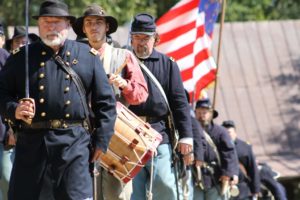 by Jessica Frierson, September 2022
by Jessica Frierson, September 2022
My favorite season of the year begins this week! Nights are getting cooler, the leaves are just beginning to turn to their lovely bright colors, and the harvest season is nearing completion. It also happens to be my favorite time for outdoor field trips. Here are five ideas for fall field trips that my family has found both fun and educational.
1. State Forest Talking Tree Trails
Fall is a great time to get out in the woods and learn about trees. The North Carolina State Forest operates seven Educational State Forests for the purpose of educating school children about our forests. They offer ranger-led classes 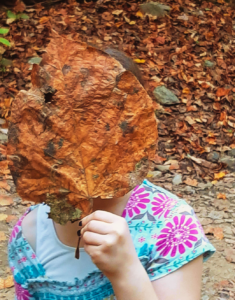 on soil, water, wildlife, and forestry. Self-guided treks along the talking tree trails are a great way to study tree identification with exhibits, tree identification signs, and a forest education center. And, of course, there are the talking trees themselves, where, at the push of a button, the “trees” tell about themselves. In addition to the seven trails that are a part of the state forest system, many other communities offer “talking tree” trails. Here are a few from across the state:
on soil, water, wildlife, and forestry. Self-guided treks along the talking tree trails are a great way to study tree identification with exhibits, tree identification signs, and a forest education center. And, of course, there are the talking trees themselves, where, at the push of a button, the “trees” tell about themselves. In addition to the seven trails that are a part of the state forest system, many other communities offer “talking tree” trails. Here are a few from across the state:
- Lenoir Talking Tree Trail | Map, Guide – North Carolina | AllTrails
- Purlear Talking Tree Trail | Map, Guide – North Carolina | AllTrails
- Clemmons Talking Tree Trail Hiking Trail, Clayton, North Carolina (hikingproject.com)
- Jordan Lake Talking Tree Trail Hiking Trail, Fearrington Village, North Carolina (hikingproject.com)
- Hendersonville Holmes Educational State Forest (ncesf.org)
2. Apple Orchards
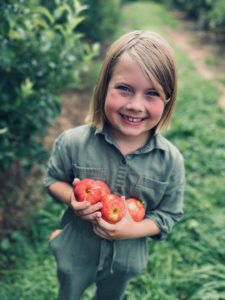 With over 40 varieties of apples grown commercially in North Carolina, you can find ripe apples from July through November. Many orchards offer activities in the fall in addition to picking apples, such as a corn maze, hay rides, or cider-making demonstrations. Henderson County is the largest producer of apples in our state and therefore, one of the best places to visit one of their numerous orchards. There are also orchards scattered throughout other areas as well. Here are a few you may like to visit:
With over 40 varieties of apples grown commercially in North Carolina, you can find ripe apples from July through November. Many orchards offer activities in the fall in addition to picking apples, such as a corn maze, hay rides, or cider-making demonstrations. Henderson County is the largest producer of apples in our state and therefore, one of the best places to visit one of their numerous orchards. There are also orchards scattered throughout other areas as well. Here are a few you may like to visit:
- Deal Orchards in Taylorsville
- Apple Hill Orchard in Morganton
- Justus Orchard in Hendersonville
- Millstone Creek Orchards in Ramseur
- Apple Farm in Gibsonville
- Horne Creek Living Historical Farm in Pinnacle: this historic working farm in the northwestern Piedmont area “ enables visitors to experience life in North Carolina’s northwestern Piedmont circa 1900.” Their orchard of over 800 trees includes 425 old southern varieties, many of which are nearly extinct. In addition to the heritage orchard, visitors to the site can also explore the Hauser family’s original farmhouse, a tobacco curing barn, a corn crib, and cultivated fields. You can also attend an old-fashioned ice cream social or corn shucking.
3. Historical Fort or Battlefield Reenactment
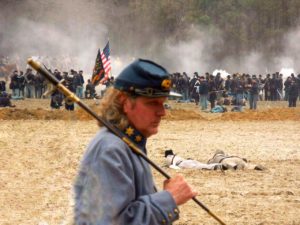 Watch history in the making (or at least pretend to) when you visit an historical fort or battlefield reenactment. Some even offer visitors an opportunity to be participants. You may even get so inspired that you get drawn into the reenactment world, like homeschooler Koleman Fritz, a reenactor drummer in the 30th North Carolina Infantry and the 9th Pennsylvania Infantry, who can be seen in the top photo.
Watch history in the making (or at least pretend to) when you visit an historical fort or battlefield reenactment. Some even offer visitors an opportunity to be participants. You may even get so inspired that you get drawn into the reenactment world, like homeschooler Koleman Fritz, a reenactor drummer in the 30th North Carolina Infantry and the 9th Pennsylvania Infantry, who can be seen in the top photo.
- Fort Dobbs is a great place to visit any time of year, but the second weekend in November is a great time to stop by to see living history displays and firing demonstrations representing veteran life from the Revolutionary War, Civil War, both World Wars, and other military conflicts.
- Although it occurs in Tennessee, the reenactment of the Battle of Blountville may still be within driving distance for many families. It takes place over the weekend of September 23-26 this year.
- Just a little way over the border into South Carolina, the reenactment of the Battle of Camden, held the second week of November, is one of the largest reenactments on the East Coast.
- The annual Kings Mountain March, a three-week-long event (yes, you read that right!) commemorating a turning point in the American Revolutionary War, begins in Virginia and passes through thirty communities before it reaches the end in South Carolina.
- Although Fort Fisher, located on the North Carolina coast, was primarily in use during the Civil War, it hosts a living history program in October called “Homefront 1942 and Fort Fisher”. This program highlights the lesser-known history of the fort as an anti-aircraft artillery training base during World War II, with a special focus on the women who provided a supporting role.
4. Balloon Fest
 Watching the ascension of hundreds of multi-colored hot air balloons is a thrilling experience! Balloon Fest is an event held annually during the third week of October in Lake Norman. It is the second oldest balloon festival in the United States. Besides the mass ascension, they have morning competitions and evening balloon glows. There is a marketplace and artisan village, a special kids’ zone, live entertainment on two stages, skydiving exhibitions, a NC wine and craft beer garden, and aerialist circus performances. That sure sounds like they have something for everyone!
Watching the ascension of hundreds of multi-colored hot air balloons is a thrilling experience! Balloon Fest is an event held annually during the third week of October in Lake Norman. It is the second oldest balloon festival in the United States. Besides the mass ascension, they have morning competitions and evening balloon glows. There is a marketplace and artisan village, a special kids’ zone, live entertainment on two stages, skydiving exhibitions, a NC wine and craft beer garden, and aerialist circus performances. That sure sounds like they have something for everyone!
5. And finally, a long-time favorite…wildlife!
 Fall is a great time to visit the NC Zoo. The cooler temperatures make it much more enjoyable to walk around and see all the exhibits. In addition, the animals are often more visible during this time since they aren’t as prone to escape the heat by hiding in the shadows. If you are on the western side of the state, you might also enjoy the WNC Nature Center in Asheville. The east coast hosts the Alligator River Wildlife Refuge, which offers free admission to its paddling and walking trails, state-of-the-art exhibits, and a wildlife drive.
Fall is a great time to visit the NC Zoo. The cooler temperatures make it much more enjoyable to walk around and see all the exhibits. In addition, the animals are often more visible during this time since they aren’t as prone to escape the heat by hiding in the shadows. If you are on the western side of the state, you might also enjoy the WNC Nature Center in Asheville. The east coast hosts the Alligator River Wildlife Refuge, which offers free admission to its paddling and walking trails, state-of-the-art exhibits, and a wildlife drive.
As the temperatures drop and the leaves begin to follow, put on your walking shoes, grab some water bottles, pack a picnic lunch, load up the family, and head out to one (or more) of these enjoyable field trips. Your children will retain more of what they learn about history, ecology, biology, and physics when they see first-hand a silken globe rising above the earth as it fills with hot air, match fallen leaves with their parent tree, or immerse themselves in the middle of a battle encampment. And the memories from these fall days will last a lifetime!
Jessica Frierson is a homeschool graduate and has been homeschooling her ten children since 2000. She serves as the secretary for NCHE, writes for GREENHOUSE, and is the lead blogger for the NCHE blog.
Hot air balloon Photo by Kyle Hinkson on Unsplash. Apple farm photo by Jennifer Baker. Reenactment photos by Stephen Fritz of the 30th North Carolina Infantry and the 9th Pennsylvania Infantry. Leaf photo and bird photo by Jessica Frierson.
What Does the Law Require of Your Homeschool?
 by Jessica Frierson, September 2022
by Jessica Frierson, September 2022
There is much confusion about the legal requirements for a homeschool. Parents opening a new homeschool have many questions. Often, much of what they have heard from others is not entirely correct. Even homeschool veterans are often mistaken about the exact requirements of the laws governing homeschools. To add to this, although they have now changed their website, DNPE previously had a somewhat confusing format on their webpages where suggestions were easily construed as requirements. The true requirements for homeschools in North Carolina are actually fairly simple.
A good place to start is to understand that in the United States, governance of homeschools is left up to each state. There are no federal guidelines for homeschools. State law can greatly vary from state to state, creating further confusion for those who have made a move from one state to another. North Carolina created the Department of Non-Public Education (DNPE) to oversee all non-public schools, which includes both private schools and homeschools. This is important to note because many people mistakenly quote rules that apply only to public schools as if they applied to all schools in North Carolina, when there is a strong division with very different rules. So let’s take a look at what the law actually says.
Legal Foundation
The basis of our legal foundation to homeschool is found in the policy section of Article 39 of Chapter 115C: “In conformity with the Constitutions of the United States and of North Carolina, it is the public policy of the State in matters of education that ‘No human authority shall, in any case whatever, control or interfere with the rights of conscience,’ or with religious liberty and that ‘religion, morality and knowledge being necessary to good government and the happiness of mankind . . . the means of education shall forever be encouraged.’”
General Statute 115C-563 defines a homeschool as “a nonpublic school consisting of the children of not more than two families or households, where the parents or legal guardians or members of either household determine the scope and sequence of academic instruction, provide academic instruction, and determine additional sources of academic instruction.”
This definition answers many questions that arise over homeschooling legalities. As you can see from the definition above, you may homeschool children from ONE additional family other than your own. To state the obvious, this would mean that a group of parents may NOT hire a teacher to homeschool all of their children. (They can open a private school and, following those separate rules and regulations, hire a teacher to teach their children, but that is not a homeschool.) This also shows us that the teaching is primarily to be done by the parent, and at a minimum, the parent or legal guardian is determining what, how, when, with what curricula and resources, etc. their children are being taught. “General Statute 115C-563(a) as amended changes the definition of a home school to allow parents to hire tutors, let their children participate in group settings where they receive instruction (co-ops, 4-H classroom instruction, etc.) and be instructed by an expert that is not a part of the household in the established homeschool (apprenticeships, a homeschool doctor teaching biology, etc.)”.
Testing
G.S. 115C-564 gives us more guidelines. First, it releases homeschools from the safety and health inspections that would otherwise be required if the school were not operating from a residence. Second, it differentiates that annual standardized testing is required, as opposed to only in certain grades as it is for private schools. DNPE gives clear guidance on how to meet this testing requirement and NCHE offers more information, as well as a listing of testing services that can be used.
Standardized testing is not the same as End-of-Grade (EOG) testing that is performed in public schools. A major difference that should be understood by both parents and students is that while the public-schooled student’s outcome on their EOGs can determine promotion to the next grade level as well as have an effect on the teacher’s performance rating, the standardized test used by homeschools is not seen by anyone other than the parent unless the parent chooses to show it to another person. It is simply administered to the student – in nearly all cases at the residence and often by the parent – and the results maintained for one year (by the parent) and “…shall be made available…at the principal office of such school, at all reasonable times, for annual inspection by a duly authorized representative of the State of North Carolina.” according to G.S. 115C-549 and 115C-557. This annual inspection in the “principal office” is mandatory but rarely requested. In recent years, families met the representative at a local library, and these meetings are voluntary. Now it is now being done virtually, and DNPE believes that these are mandatory because their legal counsel has determined that it meets the “in the principal’s office. DNPE is not concerned about how your student scores on the test, just that you meet the requirement of the law by administering it annually. So as you can see, there is no need for stressing over the standardized testing done in a homeschool, as I have written about in more detail here.
Instructors
Finally, G.S. 115C-564 states that the person who is doing the academic instruction must at least have a high school diploma. This does not preclude a sibling, for example, assisting their younger brother or sister with their school work or instruction from another individual on a particular subject, but rather that the parent who will be doing those tasks laid out in section 563 holds the minimum of a high school diploma. When opening a homeschool, you will be asked to submit a copy of your diploma or proof of graduation. This proof can also include any other verification that you had a high school diploma, such as an associate’s or bachelor’s degree or a college transcript.
Attendance
Additional records that must be maintained and shown for annual inspection include immunization records (or exemption) and attendance records. Attendance records can be kept using any method desired by the parent, including checkmarks on a wall calendar, a school planner, or this simple one-page pdf offered by DNPE. How many days must the student be in attendance? The law does NOT have a required number of days; but rather must “operate on a regular schedule, excluding reasonable holidays and vacations, during at least nine calendar months of the year.” (G.S. 115C-548) You, the administrator, determine what it means to operate on a regular basis over those nine calendar months and which months you wish to operate your school.
So the logical next question would be: precisely who is required to be in attendance? The North Carolina compulsory school attendance law (Article 26, Chapter 115C) requires that “parents and/or guardians, of children who are at least age 7 but not yet 16, ensure that their children attend school.” This brings up a common question from parents who wish to withdraw a child under the age of seven from a public school in which they had been enrolled. The schools, being notoriously – and somewhat understandably – uninformed about homeschool law, often insist that the parent show proof that the child has been transferred to a new school (the homeschool). However, this is contrary to the compulsory attendance law and to DNPE’s website, which states:
- “DO NOT send a Notice of Intent to DNPE for the present school year if the only students to be enrolled in your home school: (a) are currently under age 7 and will not turn age 7 in the present/current school year, or (b) are currently 18 years of age or older.
- Please send your Notice of Intent five days prior of your home school’s initial opening date. If any of your children will turn age 7 before this coming June 1, please send your Notice of Intent at least 5 days before the child’s 7th birthday. One Notice of Intent per school, please – not per student.”
Parents whose oldest child is under the age of seven may begin homeschooling their child as they wish to do so without opening a homeschool. Then as the oldest child is turning 7, they can officially open their homeschool.
Subjects
You may now be wondering what subjects must be taught to your child. Although the standardized testing must include English grammar, reading, spelling, and math, there are no mandatory subjects that must be studied. A good guideline to follow in this regard is to consider how best to prepare your child for life, including future career options, college or university attendance, and any unexpected circumstances such as a need to transfer to a schooling option besides homeschooling. You will want to give your child a well-rounded education which would most likely include language arts, mathematics, science, social studies/history, art, music, foreign language, health, and other subjects. A good suggestion that I have heard is to look at the minimum requirements for several different colleges or universities to ensure that your student will be able to meet those, and then work your way backwards to the level your child is currently at.
Graduation
Another noticeable absence from the list of requirements is any mention of graduation. Since the state of North Carolina regards a homeschool as an actual school in itself, the school administrator sets the graduation requirements for their school as is done in any other nonpublic school. So mom or dad, YOU decide what it will take for your students to graduate from the [home]school that you oversee. The suggestion I gave above for selecting courses of study applies to this as well. What do you think your child will need for the next step of their life after high school? Set your conditions for graduation based on that. You may find that it will even vary slightly from one child to the next, depending on their post-graduation aspirations or individual circumstances. This is particularly helpful for those families with special needs children.
Once your child has completed the courses prescribed for graduation from your homeschool, you will issue them a diploma. You can design one of your own, purchase one from a company that sells them, or order one from NCHE. Whatever source you use, the authority behind that prized piece of paper is the homeschool administrator. This is a legal document recognized by the state as proof of your child’s completion of their high school education, on equal footing with a diploma issued by any other high school in our state. If your child wishes to become a homeschooling parent one day down the road, this diploma will be what they use to open their own homeschool, as I did when I opened my homeschool several years after graduating from homeschool and receiving my diploma from my mother. Another thing to know about your high school diploma is that diplomas from online private schools which are located in other states are not recognized by the state of North Carolina. If your student graduates from one of these, you need to issue a diploma from your state-recognized homeschool.
As you can see, homeschooling in North Carolina is fairly simple. NCHE has worked hard to keep it that way, beginning years before there was any specific wording in our state statutes regarding homeschools, and continuing over the years to diligently guard the rights of parents to choose what they feel is the best educational path for their children. You can count on us to maintain that attentiveness as our lawmakers periodically attempt to introduce new legislation. We have a team dedicated to monitoring the happenings in the General Assembly, visiting our legislators in Raleigh, and building relationships with our lawmakers so that they can see firsthand what a wonderful educational choice homeschool truly is.
Jessica Frierson is a homeschool graduate and has been homeschooling her ten children since 2000. She serves as the secretary for NCHE, writes for GREENHOUSE, and is the lead blogger for the NCHE blog.
Quotes from DNPE taken from NC DOA: Home School Information and Home-School-Guidebook-2020-2021.pdf (nc.gov)
Getting Back in the Swing of Things
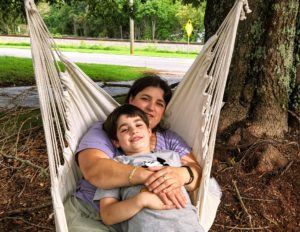 by Jessica Frierson, August 2022
by Jessica Frierson, August 2022
Many of us in the homeschool world are transitioning back into school mode from either a summer break or, for year-round schoolers, a mini-break. Our family falls into the latter camp. We took July off intending to use the time to reorganize our school room (or rather, where our school books and other materials are primarily stored) and to begin lesson plans for the new books we will be starting. Now, we are at the end of August, and I have not made much progress on either front. Sometimes it can be tough getting back into the swing of things!
We have this same problem after Christmas or upon returning from an out-of-town trip. Transitioning from vacation mode to school mode can be a challenge for anyone. Our style of homeschooling blurs the lines to some degree since we approach all areas of life as potential learning opportunities. For example, when we visit an area on vacation, we look for places of historical significance or interesting museums to check out. This style of learning is so much fun and definitely more memorable. Knuckling down and getting back to the books upon our return, though, requires the application of much self-discipline.
Pros Can Become Cons
One reason it can be hard to get back into school mode has to do with all of the wonderful reasons we homeschool to begin with. If we do not take care, the pros of homeschooling can become cons. The many bonuses tip the scales in favor of home education. But, as with all things in life, moderation in all things is needed to keep them in check.
 Flexibility
Flexibility
The freedom we have in homeschooling to schedule schoolwork around the rest of our daily schedule can wreak havoc on our school time if we do not find a good balance. It is nice to be able to take advantage of appointment openings earlier in the day instead of waiting for after-school slots. Park visits and other outings during school hours are a favorite for homeschoolers. The restrictions of typical school hours do not apply to us. I have found, however, that I need to impose restrictions on our school hours in order to control the reins on what can easily turn into a runaway horse.
As a mom to a large family, I feel pulled in many directions. Although educating my children is one of the strongest pulls on my heart, the busyness of our household tends to have a greater pull on our schedule. I fight a constant battle between enjoying our flexibility and the flexibility becoming our enemy.
 Student-led Learning
Student-led Learning
Another great aspect of homeschooling is that the schooling can follow the child’s lead. However, that too, can go in the wrong direction if we get complacent. Sometimes children don’t want to do their schoolwork. After we’ve had a break, some of my children are eager to return to our school days. Others have a hard time getting back on track. They need to learn that being responsible means doing things they don’t feel like doing at times. We have to tackle subjects that aren’t our strong points. We must pull out the books when we would rather play or do crafts. This builds character and teaches diligence, time management skills, and good stewardship practices.
Freestyle
Our family takes a fairly freestyle approach to education. I make use of a variety of resources, curriculum materials, and hands-on activities. We are not tied to a boxed curriculum or a strict school calendar. If a child brings up questions about a subject that I think might be a good path to go down, we will adapt our plans for that day to follow that line of interest. The beauty of this learning style is marred, however, if I am not careful to maintain a balance of order and structure. My weak point is consistency and following through with the lesson plans that I created. I am striving to find a better balance of freestyle and planned lessons this year.
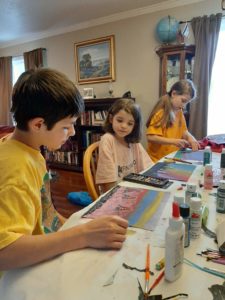 Time with Children
Time with Children
My most compelling reason for choosing to homeschool is the opportunity to spend each day with my children. I love being an integral part of their education and walking through the learning process with them each day. When we homeschool, we often spend twenty-four hours a day with our children, most days of the week. This is truly a blessing and is part of my goal in mothering. That doesn’t mean that I don’t need some space for myself occasionally. There are days that I get really “mommed out,” as I call it.
When I had a baby, a toddler, and school-age children all at once, it was a rare opportunity to get some quiet time alone. Now that my children are a little older, I make a habit of being intentional about doing this several times a week. It may be reading a book in my hammock chair in the cool of the evening while the kids are getting ready for bed. I might read my Bible early in the morning before anyone else rises for the day or announce that, “Mama is having a short rest time, so please do not knock on my door unless there’s an emergency.” I find that I am much more equipped to handle all the stresses that life brings around when I have had these short sessions of alone time to rejuvenate.
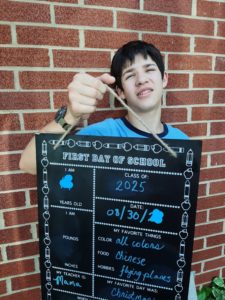 Back in the Swing of It
Back in the Swing of It
The Merriam-Webster dictionary defines this idiom as, “fully involved and comfortable with (a regular activity, process, etc.).” As we approach the end of the summer season, it is time for us to get back in the swing of our studies. That familiar feeling of mixed emotions has hit both me and my children as we feel excitement over becoming “fully involved and comfortable with” our school days and yet half-heartedly reluctant to jump back into a more disciplined regimen. How about you? Have you already begun a new school year? Does your homeschool operate on an entirely different schedule? Don’t feel you are alone in excited reluctancy. I imagine most of the homeschooling community is in the same boat!
Jessica Frierson is a homeschool graduate and has been homeschooling her ten children since 2000. She serves as the secretary for NCHE, writes for GREENHOUSE, and is the lead blogger for the NCHE blog.
Embrace the Call to Freedom
by Jessica Frierson and Emily Schrum, August 2022
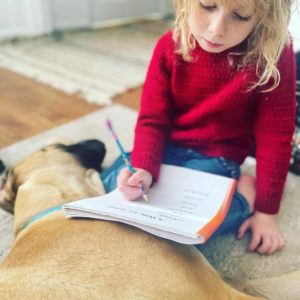 As summer draws to a close, many of us homeschool moms (and dads) are prepping for a new school year. As we peruse the Internet, gather our curriculum, and glean from the ideas of others, we must guard against allowing ourselves to unknowingly be drawn into a trap. As the sparks of inspiration fire up in our minds, they can be quickly reduced to a smolder by the feelings of inadequacy that so easily creep in.
As summer draws to a close, many of us homeschool moms (and dads) are prepping for a new school year. As we peruse the Internet, gather our curriculum, and glean from the ideas of others, we must guard against allowing ourselves to unknowingly be drawn into a trap. As the sparks of inspiration fire up in our minds, they can be quickly reduced to a smolder by the feelings of inadequacy that so easily creep in.
How can we successfully fight this battle and avoid the snare of discouragement? What steps can we take to not be enslaved by the expectations of others…or even worse, the expectations we place on ourselves? One of the most beautiful aspects of homeschooling—freedom—is easily tossed aside in our vain attempts to recreate the perfection we falsely believe others have achieved.
The words of a sweet friend offer some excellent advice. Emily has a winsome way with words that hit me right in the heart every time her posts come across my newsfeed. Her words are raw; they are real. They cut right to the point. Today, I want to share some of those words of wisdom with you.
Don’t get caught up in the perfectly-captured Pinterest homeschool post.
Some days don’t turn out “picture perfect.” Rarely. Like one in a million.
But most days look like this.
People tell me all the time, “I could never homeschool. I’m not made for that.”
They’re right. We’re not made for the facade of what homeschooling looks like. But we ARE made to rise into whatever calling the Lord beckons each of us to.
I wish I was someone who did everything with excellence as described by social media. But I believe with my whole entire heart that my humble, imperfect, messy surrender, and sacrifice is enough.
So, my days won’t look like 20 classical subjects completed with composer studies and poetry included. They won’t always look calm and under control.
Most days, my “yes” looks like getting done what HAS to get done while two out of the three binge on tv and eat Lord knows how many snacks.
I give my best. It’s not enough for everyone. But it’s enough for me, for my family, for the calling that God has called me to.
Don’t be enslaved by illusions of how it’s supposed to look. Walk in freedom that your “yes” is enough, whatever that looks like for you.
I’m cheering you on. However your homeschool, or mothering, looks today, I am cheering you on.
“It is for freedom that Christ has set us free. Stand firm, then, and do not let yourselves be burdened again by a yoke of slavery.” Galatians 5:1
So to all of you worrying if you will be ”good enough” and if you will be able to “do it right,” to those of you pinning another cute Pinterest tip that 99.99% of us will NEVER nail, to each and every one of us that are slowly slipping back into the shackles we had unlocked when we decided to homeschool: be warned!
These attempts we make to “measure up” are like the sirens of Greek mythology. The sirens were subtle but dangerous creatures whose enchanting music lured sailors to shipwreck on the rocky coasts. We place ourselves in danger of shipwrecking our own homeschool and our families when we listen to the alluring calls on social media, try to catch up with the seemingly perfect veteran homeschooler we met at our new co-op last week, or attempt to meet the goals placed by the doubting family member we’re trying to prove ourselves to. Listening to these voices puts us directly in position for the yoke of slavery to drop back onto our shoulders.
But we do not have to succumb to these burdens. The call to homeschool is coupled with the call to freedom. This is the call we must listen to and set our course to follow. So set your heart to stand firm and embrace the call to freedom.
 Emily Schrum is a homeschooling mama to three precious children. She and her husband view home education as a high calling from God and one of their greatest missions in life. Emily has a Bachelor of Science in Psychology and Christian Counseling. Right now however, she is content to stay at home, raising children and chickens all to the Glory of God.
Emily Schrum is a homeschooling mama to three precious children. She and her husband view home education as a high calling from God and one of their greatest missions in life. Emily has a Bachelor of Science in Psychology and Christian Counseling. Right now however, she is content to stay at home, raising children and chickens all to the Glory of God.
![]() Jessica Frierson is a homeschool graduate and has been homeschooling her ten children since 2000. She serves as the secretary for NCHE, writes for GREENHOUSE, and is the lead blogger for the NCHE blog.
Jessica Frierson is a homeschool graduate and has been homeschooling her ten children since 2000. She serves as the secretary for NCHE, writes for GREENHOUSE, and is the lead blogger for the NCHE blog.









